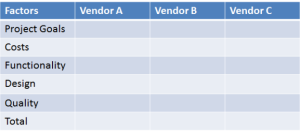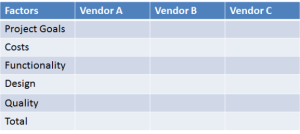Choosing the Right Website Vendor Made Easy

Planning a new website is always an exciting time for companies. It can also be a pretty overwhelming process right out of the gate for many B2B companies when you’re not sure who to call, who is going to manage the project and what firm to use. Once you’ve taken a deep breath and decide to move forward, it is likely that you will request proposals from several website design companies.
Many small and mid-sized companies assess website proposals on price alone which seems to be the obvious approach if saving money is the primary consideration for the business; however, several other non-financial factors also carry an implicit cost and failing to consider these in conjunction with price could mean that a business chooses an inappropriate supplier.
The RFP process is quite common and as we all know often very competitive. During an RFP process each web design company provides a quote which includes details of the scope of work they will undertake (based on your detailed RFQ you have provided them), associated costs and timelines.
The ideal web design company is the one that will complete your website with a combination of the lowest cost, fastest turnaround time and highest level of quality.
This all sounds pretty reasonable; however, there are several key issues that deserve some consideration.
- The lowest cost supplier might also be the slowest – it is important to have a good understanding of the timeline involved and whether your company values cost over speed
- “Cost” and “speed” are tangible factors that can be measured relatively easily – but what about quality, functionality, and the user experience. Spend some time investigating whether or not the website vendor has planned out SEO functionality for example.
- What if your requirements change during the project? We all know this can happen, as we roll our sleeves up we see new things that excite us. How will your supplier respond and manage this?
It is issues such as these that make comparing one website proposal against another quite tough. So where do you go from here?
Ultimately it comes down to knowing your business inside and out and knowing what you want out of your website. Review each proposal in depth with your guidelines of the RFP you provided each vendor and map out specific factors.
Try mapping out key factors on a grid. Here are some tips:
- Draw up a list of key factors that you want to assess your proposals on; then indicate the importance of each factor by allocating a weighing between 1 and 5. For example, if functionality is critical because your website has to be completed with some key modules to move the business forward, give this a weighting of 5. If timing is less important and you’re prepared to give up time to ensure the functionality is done right give this a lower rating and so on.
- Other important factors could include design, cost, SEO, timelines and custom modules. These would align with your RFQ goals
- Once you have your grid set up with factors down the left hand column, your vendor proposals can be created across the other columns to start your weighting. Add them up and this should give you a very good indication of who your right website vendor should be.
This tool will help guide your decision making process going forward. It will also provide you with some very good tangible feedback to provide the bidding vendors. Each have spent a great deal of time gunning for your business, at the very least it’s important to share with them exactly why they did not land the business.
.png?width=2361&height=488&name=Mezzanine%20Logo_Horiz_RGB_on%20blue%20(1).png)

